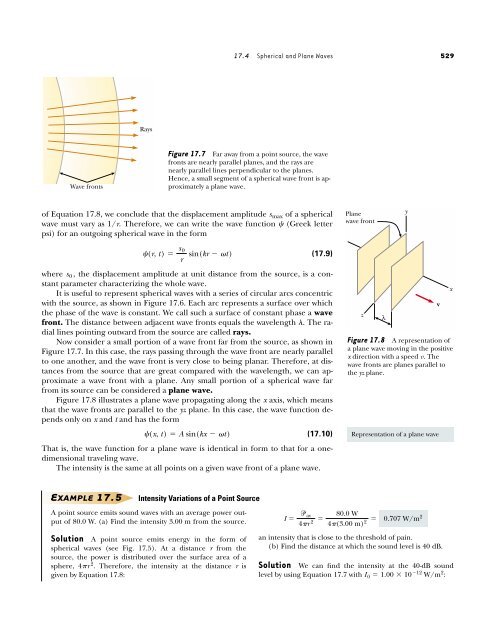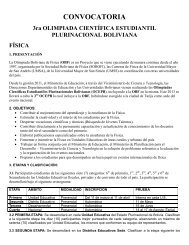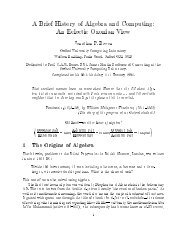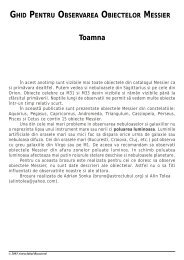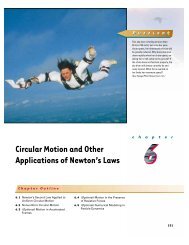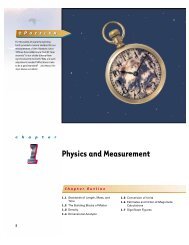Create successful ePaper yourself
Turn your PDF publications into a flip-book with our unique Google optimized e-Paper software.
Wave fronts<br />
<strong>of</strong> Equation 17.8, we conclude that the displacement amplitude s max <strong>of</strong> a spherical<br />
wave must vary as 1/r. Therefore, we can write the wave function � (Greek letter<br />
psi) for an outgoing spherical wave in the form<br />
�(r, t) � (17.9)<br />
where s0, the displacement amplitude at unit distance from the source, is a constant<br />
parameter characterizing the whole wave.<br />
It is useful to represent spherical waves with a series <strong>of</strong> circular arcs concentric<br />
with the source, as shown in Figure 17.6. Each arc represents a surface over which<br />
the phase <strong>of</strong> the wave is constant. We call such a surface <strong>of</strong> constant phase a wave<br />
front. The distance between adjacent wave fronts equals the wavelength �. The radial<br />
lines pointing outward from the source are called rays.<br />
Now consider a small portion <strong>of</strong> a wave front far from the source, as shown in<br />
Figure 17.7. In this case, the rays passing through the wave front are nearly parallel<br />
to one another, and the wave front is very close to being planar. Therefore, at distances<br />
from the source that are great compared with the wavelength, we can approximate<br />
a wave front with a plane. Any small portion <strong>of</strong> a spherical wave far<br />
from its source can be considered a plane wave.<br />
Figure 17.8 illustrates a plane wave propagating along the x axis, which means<br />
that the wave fronts are parallel to the yz plane. In this case, the wave function depends<br />
only on x and t and has the form<br />
�(x, t) � A sin(kx � �t)<br />
(17.10)<br />
That is, the wave function for a plane wave is identical in form to that for a onedimensional<br />
traveling wave.<br />
The intensity is the same at all points on a given wave front <strong>of</strong> a plane wave.<br />
s0 sin(kr � �t)<br />
r<br />
EXAMPLE 17.5<br />
Rays<br />
17.4 Spherical and Plane <strong>Waves</strong> 529<br />
Figure 17.7 Far away from a point source, the wave<br />
fronts are nearly parallel planes, and the rays are<br />
nearly parallel lines perpendicular to the planes.<br />
Hence, a small segment <strong>of</strong> a spherical wave front is approximately<br />
a plane wave.<br />
<strong>Intensity</strong> Variations <strong>of</strong> a Point Source<br />
A point source emits sound waves with an average power output<br />
<strong>of</strong> 80.0 W. (a) Find the intensity 3.00 m from the source.<br />
Solution A point source emits energy in the form <strong>of</strong><br />
spherical waves (see Fig. 17.5). At a distance r from the<br />
source, the power is distributed over the surface area <strong>of</strong> a<br />
sphere, 4�r 2 . Therefore, the intensity at the distance r is<br />
given by Equation 17.8:<br />
I � �av 4�r 2 �<br />
Plane<br />
wave front<br />
z<br />
λ<br />
Figure 17.8 A representation <strong>of</strong><br />
a plane wave moving in the positive<br />
x direction with a speed v. The<br />
wave fronts are planes parallel to<br />
the yz plane.<br />
Representation <strong>of</strong> a plane wave<br />
80.0 W<br />
4�(3.00 m) 2 �<br />
an intensity that is close to the threshold <strong>of</strong> pain.<br />
(b) Find the distance at which the sound level is 40 dB.<br />
Solution We can find the intensity at the 40-dB sound<br />
level by using Equation 17.7 with I 0 � 1.00 � 10 �12 W/m 2 :<br />
y<br />
0.707 W/m 2<br />
v<br />
x


